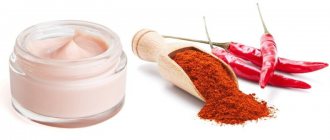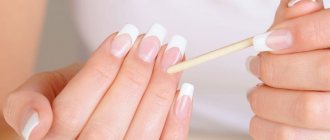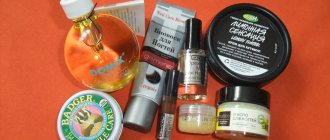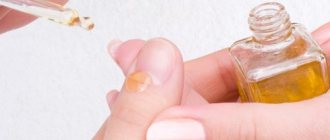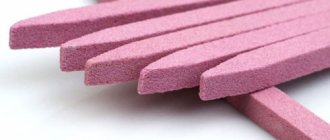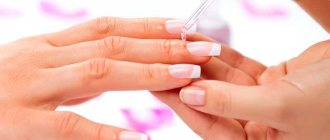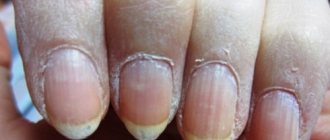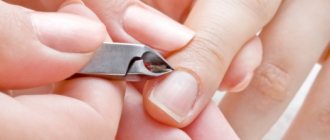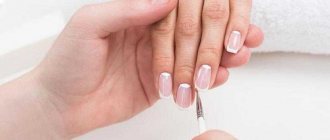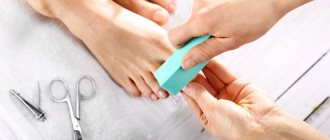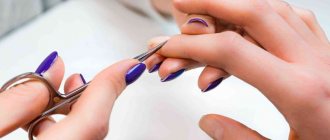What is the nail cuticle
Cuticle
The question of what the nail cuticle is has a clear answer. The cuticle is a skin rim that borders the plate, which provides the protective function of the nail. Since the cuticle is renewed cyclically, it is necessary to take care of it in a timely manner with the help of nutrients, especially in winter. The cuticle can be soft or dry, which determines its continued existence. If it is soft, then most likely it is new, which can contribute to ingrowth into the nail plate. This fact causes the unaesthetic appearance of the nail.
If the plate is dry, then tears, cracks and burrs are likely to form on it, which cause pain to a person. Such a cuticle can become an obstacle to the growth of a healthy plate.
The quality, growth and elasticity of the cuticle directly depends on a person’s nutrition, its saturation with fats, and balance.
Location of the cuticle on the nail
About the cuticle
The cuticle is a dense leathery cushion surrounding the nail plate in the lower part. It protects the nail from foreign bodies and bacteria that try to penetrate inside the growth zone.
There are dead cells at the edges of the cuticle. When they dry out and begin to peel off, hangnails appear.
The sides of the nail are surrounded by skin ridges. The skin here is also sometimes dry, which also causes hangnails to appear. If you do your manicure incorrectly, through the wounds, especially in those places where blood appears, you can get an infection and inflammation of the cuticle will occur.
After each trimming of the skin, new dense and rough skin will grow in its place. It is most susceptible to phenomena such as cracking and burrs.
Removal methods
There are several ways to treat cuticles. At home, experts recommend avoiding circumcision and simply pushing away the excess skin with an orange stick. In a salon with a trusted specialist, you can try a more intense effect.
In general, the method of removing the cuticle can be chosen depending on one’s own desires and the condition of the pterygium.
Edged
The meaning of a trim manicure is that excess skin is simply trimmed off. It is not recommended to do this yourself, so it is better to contact a professional in the salon. If a person has diabetes, then this type of processing is strictly prohibited. Cuticle trimming is carried out using standard tools: nail scissors and tweezers. The cuticle must first be softened.
Taking care of the cuticle
In order not to injure the cuticle, you can move it away rather than cut it. Wooden sticks are used for this. It is better to entrust the trimming of the delicate skin to a specialist.
Softening the skin
To make dry skin feel good, it needs to be softened. Dry areas are softened in the following ways:
- Apply nourishing and moisturizing essential oil, cream, gel or balm to the skin. Perform a light massage in the cuticle area. This procedure will improve the growth of nails, as oxygen will begin to actively flow to the border of the nail covering.
- It is recommended to treat marigolds with vitamin complexes - oil, elixir or cream enriched with vitamin E.
- Fungus causes itching. In this case, nail treatment is carried out with antiseptic and antifungal agents. During the inflammatory process, anti-inflammatory and cooling drugs are used. It is recommended that you visit a dermatologist. The doctor will conduct an examination and prescribe effective treatment.
The process of moisturizing and softening the cuticle must be included in the manicure procedure.
Applying oil
Essential or vegetable oil, as well as a gel based on it, will help remove dryness and itching in the cuticle area.
To nourish and soften the skin, use castor, burdock, almond, and apricot oil.
Very dry areas of skin and nails are carefully treated with the selected product.
The stratum corneum of the cuticle can only be softened using a special product. For this, a special gel or cream is used, which contains an alkaline component, which successfully softens the skin and prepares it for painless removal.
Products that help care for cuticles:
- each gel consists of a large amount of oil and different extracts. Always buy natural cuticle care products;
- You can remove the skin using a special natural pencil for the delicate skin near the nails, which successfully dissolves the keratinized layers near the nails;
- cuticle treatment is also carried out with an elixir, which comprehensively cares for the skin and nourishes it well;
- To allow the cuticle to breathe, its dead areas are removed using an exfoliator and a manicure stick.
Manicure sticks successfully cope with the procedure of removing excess skin from the nail bed. Therefore, it is recommended to use them so as not to harm the skin or cause an abscess. Manicure sticks should be made from natural orange branches.
Home care
Cuticle care at home is carried out using the following recipes:
- Mix tea tree essential oil (3 drops) with lavender oil (2 drops). Heat the resulting mixture a little and rub it into the cuticle area. Carry out the procedure daily.
- Mix castor oil (20 milliliters) with 10 drops of iodine. Shake the bottle well. Gently rub the resulting gel into problem areas. There is no need to rinse off, it is important to wait until it dries completely, after which you can proceed with your business. Use iodine oil every day.
- Baths will help soften the skin. Dissolve a tablespoon of baking soda in a glass of warm water. It is recommended to take soda baths for fingers for 20 minutes. Then, using a wooden stick, carefully peel back the skin and cut off the excess layer. It is recommended to do soda baths once every seven days.
- To make the skin flexible, baths with liquid soap are often used. Add a teaspoon of liquid soap and peach or apricot oil (a couple of drops) to a glass of water. Soak your fingers in the water for 15 minutes. After the bath, push back the cuticle with a manicure stick and cut off excess skin.
Baths, essential oil, gel and other products successfully care for and treat nails and cuticles.
What is the cuticle made of?
The structure of the nail cuticle is as follows:
- Eponychium. The top layer of the cuticle contains blood vessels and provides protection to the nail. It is careless use of manicure tools that leads to her cuts.
- Pterygium. The lower part of the cuticle represents the remains of the original layer, that is, a thin film that fuses with the plate. More often in males and children it occupies more than one third of the surface of the plate.
Structure of the cuticle
The edges of the cuticle are keratinized cells, which, when drying and peeling off, contribute to the formation of hangnails. They can occur due to insufficiently careful nail care, which manifests itself in the use of household chemicals based on acids and alkalis without gloves.
The cuticle is not an unnecessary element; it is “conceived by nature” to protect the delicate component of the nail - the matrix, which is the germinal area of the formation and development of new plate cells.
It is noted that frequent, systemic removal of this protective layer can lead to even more rapid and intense growth; this process is determined by the protective function of the human body. Therefore, there have been debates among manicurists for many years about removing or leaving the cuticle. It has been revealed that from frequent mechanical removal of it, the skin at the base of the nail turns red and swelling appears.
Supporters of “healthy” nails are of the opinion that this film should not be completely removed, but it is necessary to remove the pterygium with manicure tools, which creates the picture of unkempt and unsightly nails. The presence of eponychium is completely natural. Therefore, it is enough to polish it using hardware manicure. This can only be done by a specialist competent in this matter, since there is a high risk of injury to the cuticle and infection.
The pterygium must be removed due to the fact that excess skin in the periungual space clings to the plate and reduces its growth rate, which is reflected in the appearance of grooves and irregularities on the plate. The materials adhere extremely poorly to lumpy and rough nails. The excess cuticle that grows on the nail gradually loses moisture and cracks.
The following two parts of the cuticle are also distinguished: thick internal laminar and thin external.
The first consists of an internal endocuticle and an external exocuticle. These components consist of a glycoprotein, which is a chitin complex belonging to the category of high molecular weight polysaccharides, and protein.
The pore tubules in this film are unique pathways for the movement of secretions secreted by epithelial cells, these include wax, tannins and material for creating the cuticle.
Thin cuticle
You might think that there can be no problems with a thin cuticle, because it looks quite inconspicuous and requires almost no care. But that's not true. Although this type of skin is quite thin, it still requires care, since the cuticle is very sensitive and can tear from slight friction or damage. Therefore it should be leveled.
The main problem of thin cuticles is closely located vessels that do not tolerate the intervention of trimmed manicure. This skin especially does not like manicure with nippers, which tear the cuticle in several places (as opposed to scissors, which smoothly cut off the skin line), and then due to such minor damage, hangnails form. Sometimes the cuticle looks like a solid hangnail.
You need to remove cuticles using special acid-based softeners. These preparations loosen the skin and allow it to be carefully processed. At the same time, it is not at all necessary to take a bath before treating your hands. And if you want to work with the device, then you can do without a bath and without a softener. It should be remembered that the thin cuticle cannot be removed completely; you need to leave a thin strip of skin that will protect the nails from further damage and microtrauma.
§ 41. The meaning of skin and its structure
Remember
1 question
What body coverings are found in animals?
Answer:
The external integument of animals is represented by skin or integument. In invertebrates, the body covers are represented by ectoderm, in arthropods there is a chitinized cuticle and shell, in vertebrates there is skin with horny formations, feathers, and wool.
2. Question
What are the body coverings of mammals?
Answer:
The integument of the body of mammals is represented by skin. Surface mammals have fur on their skin; aquatic mammals have no fur.
1 question
Describe the significance of the skin.
Answer:
The skin has a protective function: it is strong, elastic, protects internal organs from mechanical damage (impacts, bruises) and from loss of water; Thanks to skin receptors we feel pain, temperature changes, and touch. The skin protects the body from overheating and cooling and is involved in maintaining a constant body temperature. Some harmful substances and excess salts are released through the skin in the form of sweat. The skin also takes part in the exchange of gases, absorbs oxygen, and releases carbon dioxide.
2. Question
Find in fig. 71 two layers of skin and subcutaneous fat; tell us about their functions.
Answer:
There are two main layers of skin: the outer - epidermis, the inner - dermis and subcutaneous fatty tissue - hypodermis.
The epidermis is the outer layer of the skin, formed by epithelial tissue.
The function of the epidermis is to protect the skin from the action of solid particles, gases, and liquids.
The dermis is the second layer of skin formed by connective tissue.
Function - ensuring elasticity, nutrition (due to a large number of blood vessels), secretion (sebaceous and sweat glands), providing hair.
Hypodermis is subcutaneous fatty tissue, this is the deepest layer connecting the skin with bones and muscles. It protects internal organs from bruises, sudden shocks, and hypothermia. Spare nutrients - fats - are deposited in it.
3*. Question
How does a tan form?
Answer:
The living cells of the outer layer of skin contain the pigment melanin. Which determines the color of the skin and protects the body from the sun's rays. When the amount of this substance increases, a tan forms.
4. Question
What is the function of the sweat and sebaceous glands? Why do the ducts of the sebaceous glands flow into the hair follicle, where the hair roots are located?
Answer:
Sweat glands secrete sweat. When sweat evaporates, the body cools, which saves the body from overheating, and harmful substances and excess salts are also released along with sweat.
Sebum is produced in the sebaceous glands. The ducts of the sebaceous glands flow into the hair follicle and through it lubricate the hair and the surface of the skin, which gives it softness and elasticity.
5. Question
Tell us about the function of nails. Why shouldn't you chew them?
Answer:
Nails are horny formations of the skin. Nails protect your fingertips from damage. You should not bite your nails because you can become infected with infectious gastrointestinal infections due to the accumulation of dirt deposits under the nails that are not washed out with periodic hand washing; the formation of a hangnail can lead to inflammation - felon; A bitten nail ruins the aesthetic appearance of your hands.
6. Question
Name the properties of oily, dry and normal skin.
Answer:
There are oily, normal and dry skin.
Oily skin shines and shines, its pores are clearly visible, which is why it resembles an orange peel. In the pores of oily skin, a local inflammatory disease often occurs - acne. Oily skin leaves marks on a paper towel when pressed against your face. Dry skin is thin, often flaky, and prone to cracking. Normal skin does not have these shortcomings.
cuticle
(from Latin cuticula - skin), in animals - a dense non-cellular formation on the surface of epithelial tissue cells.
In invertebrates, cells are a derivative of the single-layer integumentary epithelium (hypodermis); performs ch. arr. protective and support functions. It can harden (for example, in arthropods), so during the growth of the animal it is periodically shed (see MOLTING). The composition of K. usually includes chitin, which, together with minerals and proteins, gives K. its mechanical properties. strength, and lipids that contribute to its water resistance. First appears in protocavitary worms. In different groups of invertebrates, K. is chemically different. composition (main sample of proteins) and structure. K. derivatives—scales, scutes, hairs, bristles.
In vertebrates , K. is a collection of microvilli on the surface of epithelial cells lining the inside. organs (intestines, airways, parts of the urinary tubules of the kidneys and urinary tract). The presence of enzymes in K. indicates its participation in the functioning of organs. In plants, there is a layer of fatty substance (cutin) covering the surface of the above-ground (mostly leaves, stems, some fruits) organs with a continuous film. plants. Low permeability to aqueous solutions, gases, pathogens. Cutin is synthesized by epidermal cells and released outward, forming cutin and partially permeating the outer wall of the cell membrane. The complex of calcium and the cutinized shell includes cellulose, pectin, cutin, wax, and other encrusting substances and has a layered structure. The thickness of K. is penetrated by a network of hydrophilic pectin capillaries. The degree of development of the epidermis and the nature of the distribution of wax and hydrophilic capillaries in it largely determine the protective properties of the epidermis and depend on the living conditions and age of the plant. Powerful, densely covered with wax crystals is a characteristic feature of xerophytes. The relief of K. repeats and often enhances the relief of the outside. epidermal cell walls, resulting in a species-specific surface structure (diagnostic sign).
Source: Biological encyclopedic dictionary on Gufo.me
Meanings in other dictionaries
- Cuticle - (cuticula; diminutive of the Latin cutis skin) 1) a dense formation on the surface of certain epithelial cells, consisting of the secretion of these cells; 2) a system of microvilli on the free surface of intestinal epithelial cells; 3) structureless shell... Medical encyclopedia
- cuticle - In animals - a dense non-cellular formation on the surface of epithelial tissue cells, primarily performs protective and supporting functions. In roundworms, the cuticle is secreted by the epidermis, covers the body and lines the oral cavity and pharynx. Biology. Modern encyclopedia
- cuticle - Cuticles, g. [latin. cuticula – skin] (bot.). A thin film at the end of plants that protects the plant from excessive evaporation. Large dictionary of foreign words
- CUTICLE - CUTICLE (from Latin cuticula - skin) - in animals, a dense formation on the surface of epithelial tissue cells; plants have a thin film impregnated with cutin and covering the epidermis of leaves and stems. Performs protective and support functions. Large encyclopedic dictionary
- Cuticle - (from Latin cuticula - skin) 1) in animals - a dense formation on the surface of epithelial tissue cells. In invertebrates, it is a derivative of cells of the single-layer integumentary epithelium (see Hypodermis). Performs mainly protective and support functions. Great Soviet Encyclopedia
- cuticle - orf. cuticle, -s Spelling Dictionary Lopatin
- cuticle - KUT'IKULA, cuticles, female. (·lat. cuticula - skin) (bot.). A thin film at the end of plants that protects the plant from excessive evaporation. Ushakov's Explanatory Dictionary
- CUTICLE - CUTICLE, the thin outer layer of the animal's body. In humans, the term refers to the epidermis, especially the dead skin at the ends of the fingers. Scientific and technical dictionary
- Cuticle - See Peel. Encyclopedic Dictionary of Brockhaus and Efron
- cuticle - CUTICLE (from Latin cuticula - skin), in the region - a thin film covering the epidermis of leaves and stems and performing a protective function. Agricultural Dictionary
- cuticle - CUTICLE - 1. A thin, smooth, sometimes folded or tuberculated, transparent structureless film covering the outer side of the epidermis of leaves and stems and interrupted only above the stomata and lentils. Botany. Glossary of terms
- Blog
- Jerzy Lec
- Contacts
- Terms of use
© 2005—2021 Gufo.me
How to properly care?
It is important not only to know how to remove cuticles correctly, but also to understand that nail care is mandatory. Experts recommend doing the following:
- Do housework only with protective gloves;
- Treat your nails regularly, preventing excessive cuticle overgrowth;
- Use moisturizing creams;
- Use special baths that strengthen the nail plates regularly;
- Keep your hands clean and use soap with a creamy texture and caring effect for daily care.
These recommendations are not difficult to follow; the main thing is to take daily care of your hands, which will prolong their youth.
What it is?
The cuticle on the nails is a leathery seal at the bottom of the nail plate, also called a leathery roller. Partially it goes under the skin, so only its dried edge is visible to the eye. In the medical lexicon it is called pterygium, and the remaining part of the cuticle is called eponychium. The cuticle as a whole is responsible for protection. Without the leathery cushion, bacteria would easily penetrate under the nail, disrupting its natural development. The cuticle protects the nail bed and its matrix, that is, the root part, from both moisture and air. If the root were damaged, the nail itself would begin to break, peel and develop worse.
By the way, the continuation of the matrix - the lunula - does not protect the cuticle, so it must be taken additional care.
Rules for removing gel polish from cuticles
Often, inexperienced ladies apply gel polish not only to the nail itself, but also to the cuticle. In this case, you can remove the composition from the skin in the following ways:
- moisten a cotton swab or the tip of an orange stick in varnish solvent;
- Some masters recommend washing your hands with soap several times after the procedure, and then applying more caring cream to the fabric. Due to this, after a couple of hours it will be much easier to remove excess varnish;
- If the varnish gets on the cuticle in hard-to-reach places, you can remove it using a toothpick and a cotton wool wrapped around it, which will be soaked in a solvent.
Some masters prefer to use old brushes to combat unruly varnish, thanks to which they can remove large stains on the cuticle.
Nail Polish for removing polish
How to choose a lamp for shellac can be found here.
